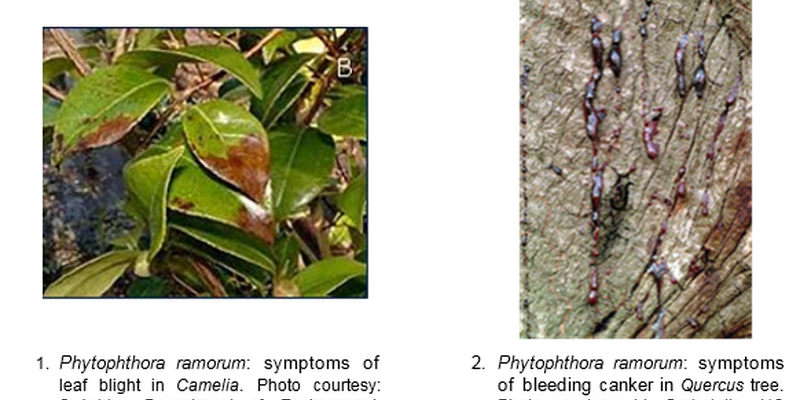Test the pest! - Two new IPPC Diagnostic Protocols adopted
Posted on Чт, 17 Авг 2017, 10:22

The IPPC Secretariat is happy to announce that there are two new diagnostic protocols (DPs), which have been adopted by the Standards Committee (SC) on behalf of the Commission on Phytosanitary Measures (CPM) as the DP Notification Period just closed on the 15 August 2017. These two newly adopted DPs are:
- DP 23: Phytophthora ramorum (2004-013)
- DP 24: Tomato spotted wilt virus, Impatiens necrotic spot virus and Watermelon silver mottle virus (2004-019)
These two newly adopted DPs should help countries prevent the entry or establishment of pests from some of the important commodities traded globally, such as many species of vegetables and ornamental plants, and also help protect trees and forests.
Twenty four diagnostic protocols (DPs) are now in the suite of adopted annexes to ISPM 27 (Diagnostic protocols for regulated pests) providing specific guidance for how to diagnose a wide range of pests - insects, nematodes, weeds, bacteria, fungi and viruses. DPs are developed by drafting groups that consist of diagnostic experts, reviewed by the Technical Panel on Diagnostic Protocols (TPDP) - a group of international experts nominated by the Standards Committee (SC), submitted to international consultations and reviewed by the SC. This complex and long process ensures that the adopted DPs reflect international best practices and that the guidance they provide is applicable to phytosanitary systems globally. Good diagnostics rely on a number of factors including the availability of human and financial resources, but having support from internationally accepted protocols is also crucial, especially for those countries that do not have the resources to develop protocols of their own.
As outlined in the CPM Recommendation 7, accurate and rapid pest diagnosis underpins phytosanitary certification, import inspections and the application of appropriate phytosanitary treatments.
- DP 23: Phytophthora ramorum (2004-013)
The newly adopted DP 23 Phytophthora ramorum (Sudden oak death (SOD), ramorum leaf blight) is a fungi-like pathogen (oomycete) of unknown origin, introduced into Western North America and Western Europe in the late twentieth century by the ornamental plant trade. It attacks a wide range of trees and shrubs in nurseries and in the field, causing leaf blight, stem cankers, bleeding stem lesions and dieback.
In North America, the pathogen was found in the early 1990s causing mortality of Quercus (oak) trees and Lithocarpus densiflorus (tanoaks), mainly in California and Oregon. Named sudden oak death (SOD), this disease has now reached epidemic proportions in North America. The disease has also been found in Canada.
In Europe, P. ramorum has been observed in Germany since 1993 causing twig blight of rhododendron in nurseries and on mature bushes in gardens. In the Netherlands, it was found in 1998 on diseased Viburnum sp. and now has been recorded in more than 20 European countries. In 2009, P. ramorum was unexpectedly found infecting and killing large numbers of Larix kaempferi (Japanese larch) trees in Southwest England. Heavy dieback and mortality of L. kaempferi in Western Britain and Northern Ireland have resulted in the felling of 600 000 trees.
This emphasizes that although many of its hosts are known, P. ramorum still poses a substantial threat to tree species and other ecologically important plants such as heathland species. The pathogen is, however, most commonly observed on Camellia, Magnolia, Pieris, Quercus (in particular the red oak species Q. acuta, Q. agrifolia, Q. cerris, Q. chrysolepis, Q. ilex and Q. rubra), Rhododendron and Viburnum.
DP 24: Tomato spotted wilt virus, Impatiens necrotic spot virus and Watermelon silver mottle virus (2004-019)
The genus Tospovirus includes the plant-pathogenic, thrips-transmitted members of the family Bunyaviridae. There are 11 definite members of the genus Tospovirus, of which Tomato spotted wilt virus (TSWV) is the type species, and at least 15 tentative members.
Tospoviruses cause devastating crop losses because of their wide distribution, broad host range (approximately 1 000 plant species) and the circulative replicative relationship between the virus and its vector. This diagnostic protocol covers the three most economically important tospoviruses: TSWV, Impatiens necrotic spot virus (INSV) and Watermelon silver mottle virus (WSMoV).
Examples of economically important hosts for TSWV are Arachis hypogaea (peanut), Capsicum annuum (sweet pepper), Carica papaya (papaya), Lactuca sativa (lettuce), Nicotiana tabacum (tobacco), Solanum lycopersicum (tomato) and Solanum tuberosum (potato). Ornamental hosts for TSWV include Alstroemeria spp., Antirrhinum spp., Begonia spp., Celosia spp., Gerbera spp., Impatiens spp., Iris spp. and Zinnia spp.
INSV also causes significant damage in vegetable crops as well as in ornamental plants, including Ageratum spp., Begonia spp., Chrysanthemum spp. and Impatiens spp.
WSMoV is a pathogen of cucurbits, the principal hosts being Citrullus lanatus (watermelon) and Cucumis melo (melon). Spread or movement of all three of the viruses and their vectors on infected nursery stock is common, making detection and removal of infected material crucial.
The three viruses are all transmitted and spread in nature by thrips (Frankliniella spp. and Thrips spp.). The viruses are not reported to be seed- or pollen-transmitted or mechanically transmitted by contact between plants. Experimentally, however, they may be transmitted mechanically or by grafting.
Read more about the work on DPs and the TPDP at https://www.ippc.int/en/core-activities/standards-setting/expert-drafting-groups/technical-panels/technical-panel-diagnostic-protocols/.
The newly adopted DPs will soon be available at the Adopted Standards (ISPMs) webpage at: https://www.ippc.int/en/core-activities/standards-setting/ispms/.
For more information on the DP Notification Period, please visit https://www.ippc.int/en/core-activities/standards-setting/notification-period-dps/.

